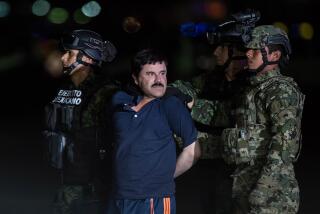Revolt’s Harsher Side Seen in Panama Seaport
COLON, Panama — In the national revolt against Gen. Manuel A. Noriega, this unruly seaport at the Caribbean end of the Panama Canal has felt the same lash of rubber truncheons, birdshot and tear gas as the sophisticated, modern capital, Panama City. But the protest here has had a harsher quality, born more of unrelieved poverty and mean lives than of distaste for the dictator who is accused of drug trafficking.
Except for its sparkling but isolated Duty Free Zone, Colon is a ramshackle port town, characterized more by brawling dockworkers and sailors than by the mostly well-behaved middle-class office workers and professionals who have been the unlikely firebrands of the revolution in the capital city.
As a result, according to some of the people who took part in recent clashes with riot troops, the character of the rebellion has been tougher and more unpredictable, explosive enough to frighten authorities into clamping a dusk-to-dawn curfew on Colon, the only city in Panama to be so affected.
The street conflicts started in Colon last Monday, when hundreds of unpaid teachers began what Agatito Guerrero, one of their leaders, called “a peaceful, nonviolent, three-hour march.” Like her colleagues in the 30,000-member Independent Assn. of Panamanian Educators, Colon’s 2,500 schoolteachers blame Noriega for the cash-pinched government’s failure to pay them.
“We walked because there was no pay, but also we demonstrated for liberty in Panama and against Noriega,” said Guerrero, 34, a lawyer and law professor who also teaches 5th grade in an elementary school here.
“People who were not teachers threw stones at the police, and they replied with tear gas and birdshot,” said Cecilio Cobham, a member of the teachers’ union and director of the local, government-run Institute of Culture.
During the melee, scores of young people who were not taking part in the protest march took advantage of police preoccupation with the teachers and began looting stores and shops. Although most of the looters appeared to belong to the city’s hungry and unemployed poor, Cobham, who was more forgiving than most of his fellow teachers concerning the behavior of the riot troops, characterized them as “hooligans simply having fun.”
“They weren’t robbing food, they were robbing liquor, TV sets, stoves, beds, rat traps,” Cobham said. “That’s not hunger.”
A guard at a shipping agent’s office at the port said that one looter was run down by the riot police and shot to death and that another was shot and may have died, but his acount could not be confirmed.
According to Guerrero, 60 to 70 people, five of them members of the teachers’ union, were arrested. “Many of them were hit by birdshot and beaten by the police, and they were held without being attended by a doctor,” Guerrero said.
Most of the detainees were released, he said, but the five teachers remain in custody pending bail payments of “$500 apiece in cash.”
“The government won’t take checks,” Guerrero said ruefully.
Dockworkers Joined Strike
As the teachers repeatedly engaged riot troops in three days of bloody, “nonviolent” protest marches, Colon’s traditionally pro-government dockworkers also went on strike. But their protest against a cashless payday lacked the fervor of the educators’ confrontations.
“Many times we have tried to unite with them (against the regime) and they have betrayed us,” Guerrero said scornfully of the dockers. “They’re on strike only because they haven’t been paid.”
But the port workers’ action had a sharper economic impact than the teachers’ street battles because it effectively shut down Colon’s showcase Free Zone, through which more than $4 billion worth of goods are funneled annually.
The Free Zone is a fenced and carefully guarded enclave of shipping companies and wholesale and retail outlets that operate with special tax-free incentives, mostly displaying, warehousing and transshipping goods meant for Panama and other Western Hemisphere countries. In contrast to the squalor of downtown Colon, whose rotting wooden buildings make it look like a discarded Humphrey Bogart movie set, parts of the neatly subdivided Free Zone are almost as elegantly appointed as Rodeo Drive in Beverly Hills.
“When the port workers stopped loading and unloading ships, that was the end,” lamented Gustavo Vivas, a Colombian businessman who plays a commercial middleman role in the Free Zone.
But unlike Panama City, where almost all the strikers and protesters in recent weeks have blamed Noriega for the country’s economic and political problems, the dockworkers who have virtually shut down the Free Zone of Colon remain basically pro-government.
“Look, politics is one thing, pay is another,” said one idled dock man outside the port workers’ union headquarters near the deserted piers.
“It’s all the fault of the United States,” complained a union official who refused to give his name.
As three U.S. reporters who had become accustomed to being welcomed warmly by anti-Noriega strikers in Panama City drove away from the Colon dock, a chorus of shouts from striking dockers followed them: “Yankee go home!” they called, “Yankee go home!”
More to Read
Sign up for Essential California
The most important California stories and recommendations in your inbox every morning.
You may occasionally receive promotional content from the Los Angeles Times.










